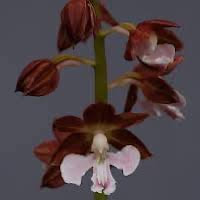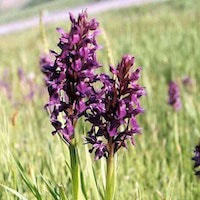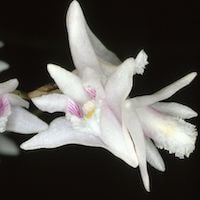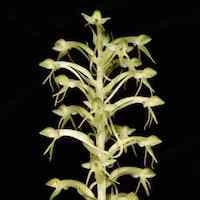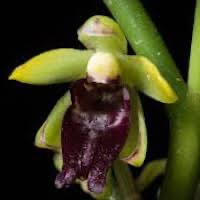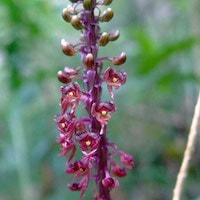WWD12 - Women's Woody 12 - Poppy Go Lucky
|
Native Singaporean Orchid notes: Sophrolaeliocattleya Dream Walk
Sophrolaeliocattleya Dream Walk is a captivating orchid hybrid celebrated for its delightful fragrance. It combines traits from two orchid species, prominently featuring the walkeriana parent in its lineage. Named for its blend of Sophronitis, Laelia, and Cattleya genera, it's known as "Dream Walk." This hybrid is compact, adorned with large lavender flowers emitting a potent, pleasant scent. While specific notes aren't detailed, typical orchid scents range from sweet floral to spicy or citrusy. Its aromatic charm is highlighted in Woody 12 perfume, designed for women's team-building workshops, fostering unity through personalized scent experiences.
|
Therapeutic Orchid notes:
|
Genus: Calanthe Brown
Calanthe, known as Christmas orchids, encompasses around 220 species celebrated for their fragrance and diverse names like "Xiaji Lan" in Chinese and "Ebine" in Japanese. These terrestrial plants feature thick roots, small oval pseudobulbs, and large corrugated leaves. Their flowers boast narrow sepals and petals, with a labellum sporting spreading lobes, contributing to their elegance. Calanthe orchids exhibit a sympodial growth pattern with short stems and spirally arranged leaves. They produce striking flowers in clusters, adding to their visual appeal. Notably, Calanthe was the first orchid species artificially hybridized, reflecting their enduring allure among enthusiasts and botanists. |
|
Dactyloriza umbrosa (Kar and Kir.) Nevski
Dactylorhiza umbrosa, commonly called Dark Dactylorhiza or "Yin Sheng Zhang Lie Lan" in Chinese, thrives in temperate and sub-arctic regions across Asia, including Pakistan, Afghanistan, and northern Iran. This robust orchid species is notable for its tubers, traditionally used in preparing salep, a creamy beverage enjoyed for its vanilla-like flavor. Salep has culinary and medicinal uses, particularly as a warming drink in winter. However, conservation efforts are crucial due to concerns over the sustainability of orchid tuber harvesting, aiming to protect wild populations and preserve their ecological roles. |
|
Dendrobium nodosum Dalzell. syn. Flickingeria nodosa (Dalzell) Seidenf.
Dendrobium nodosum, also known as Flickingeria nodosa, is an epiphytic orchid species native to India and known locally as "Purushratna" in Kannada and "Jiwanti" in Ayurveda. It features creeping rhizome stems and slender, erect or pendulous, branching pseudobulbs. In Uttara Kannada, Karnataka, it is used to prepare a sweet halva that serves as an expectorant in Ayurvedic medicine, treating respiratory ailments like asthma and bronchitis, and balancing "tridosha" imbalances. Scientific studies highlight its antimicrobial properties against bacteria like Staphylococcus aureus and antifungal effects against Trichophyton mentagrophytes. Additionally, its matured fruits are traditionally believed to enhance sexual vitality. Further research is needed to explore its full therapeutic potential. |
|
Habenaria furcifera Lindl. Syn. Habenaria ovalifolia
Habenaria furcifera, known as "Mihuayufeng Hua" in Chinese, is a terrestrial orchid found in deciduous forests across Asia, including India, Pakistan, Myanmar, and China. Blooming mainly from August to September, it displays delicate flowers of notable beauty. In Ayurvedic medicine, its tubers are prized for treating wasting diseases, fevers, blood disorders, and hemorrhages. Externally, a paste made from its tubers aids wound healing and snake bite treatment. While valued in traditional medicine, further research is needed to validate these uses scientifically. |
|
Luisia teres (Thunb.) Blume
Luisia teres, also known as Thunberg's Luisia, is an epiphytic orchid celebrated for its unique fragrance and recognized by various Chinese names like Jinchajiao (gold hairpin) and Chaizigu (bunched hairpins). It features long, slender stems with numerous leaves and blooms from March to May, showcasing its beauty on tree trunks in open environments. In traditional medicine, it is used for treating edema caused by fractures and is valued for its anti-inflammatory properties. It has also been employed historically to address tumors and counteract poisons, particularly in managing severe conditions like carcinoma and malaria. Despite its long-standing use, further scientific research is needed to validate its medicinal benefits thoroughly. |
|
Malaxis versicolor (Lindl.) Abeyw. Syn. Microstylis vesicolor Lindl., Seidenfia versicolor Marg. and Szlach.
Malaxis versicolor, known as Jeevak, is esteemed for its captivating fragrance and unique color variations influenced by light intensity. In bright light, it appears pure green; in shade, it turns deep purple; and in intermediate conditions, it shows a yellowish tint. This orchid holds significant traditional medicinal value in western India, where it is used to treat fever, biliousness, and infantile epilepsy. Jeevak is also recognized for its role in Ayurvedic medicine as a tonic and aphrodisiac, addressing diverse conditions from dysentery to rheumatism and insect bites. Despite its traditional uses, further scientific research is needed to validate its medicinal efficacy and safety for broader applications. |
Other scent note
Sweet Indian Sandalwood, balsamic, wood mix, Belambra tree, Larch, Neem, Muhuhu
Scentopia Library Reference ingredient
Amber - Check details at Scentopia's scent library
Download the guided mediation that works best with this Orchid fragrance oil
| women_woody_essential_oil_orchi_00012.mp3 | |
| File Size: | 90354 kb |
| File Type: | mp3 |

